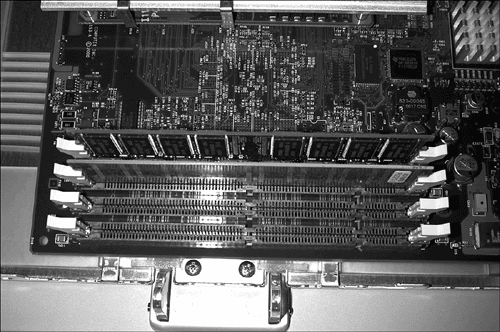Using Internal Interfaces
| There are numerous types of internal interfaces you will never deal with unless you build your own Mac or do complex repairs. However, some of the internal interfaces are important to understand because you use them to expand your system. AirPortAll modern Mac models provide an AirPort card slot in which you can install an AirPort card to add wireless networking capabilities to the machine.
ATAThe AT Attachment (ATA) interface is a PC standard specification for hard disk drives and has been adopted on modern Macs. The ATA interface provides high-speed communication, and because it is a PC standard, ATA hard drives are inexpensive. As with other specifications, there are various "flavors" of the interface, with each offering a specific speed. For example, modern PowerMac G4s use the Ultra ATA/100 standard, which means that the throughput of devices using this standard is 100 megabytes per second (MBps). If you add additional hard drives to a modern PowerMac G4, or replace an existing drive with a larger one, make sure that the drive you use is an Ultra ATA/100 drive. Other Mac models might support different ATA specifications. When replacing or adding hard drives, make sure that the drive you add is appropriate for the ATA specification your Mac supports. NOTE When you deal with internal devices, you might also hear the term IDE, which stands for Integrated Drive Electronics. IDE devices are those on which the controller is integrated into the device rather than being provided by the computer. This term is often used as a synonym for ATA because ATA devices are also IDE devices. But IDE refers to the general technology, whereas ATA refers to a specific specification. DIMM and SO-DIMMThe Dual In-line Memory Module (DIMM) interface is the standard for RAM chips in all modern Macs. DIMM chips use a 64-bit path. You use this interface when you want to expand the RAM capability of your Mac (see Figure 20.6). Figure 20.6. You can add more RAM to available DIMM slots such as those in this Power Mac G4 (you can see that this Mac still has two open DIMM slots).
PowerBooks and iBooks use Small Outline-DIMM (SO DIMM), which is a physically smaller interface, but provides the same capabilities as the full-size DIMM. SCSIEarlier in this chapter, you read that SCSI was once a standard external interface. Because of its speed advantages, it was also a standard internal interface that was used for all Mac hard drives. In fact, Apple was the only manufacturer that included the SCSI interface and drives as standard equipment. This speed advantage was one reason that the Mac became popular with graphics professionals and others who needed to move lots of data quickly. In an effort to cut the cost of its machines, Apple did away with the SCSI interface as the standard one for internal data communication. At the same time, the speed of the PC standard interface, ATA, increased such that this imposes little to no performance penalty for modern Macs. (FireWire replaced SCSI to connect external devices.) However, Apple still offers the SCSI interface and SCSI drives as an option for new Power Mac G4 machines for those users who need absolutely top-level performance. There is more than one SCSI standard, each of which offers a specific speed along with other specifications. Some examples are the following:
The various SCSI specifications use various connectors and cables it is usually impossible to connect a device using one standard to an interface that uses another. As with other interfaces, the actual speed of communication across a SCSI interface defaults to the maximum speed of the lowest-speed device that is connected to the interface. |
EAN: 2147483647
Pages: 260
 To learn more about AirPort,
To learn more about AirPort, 